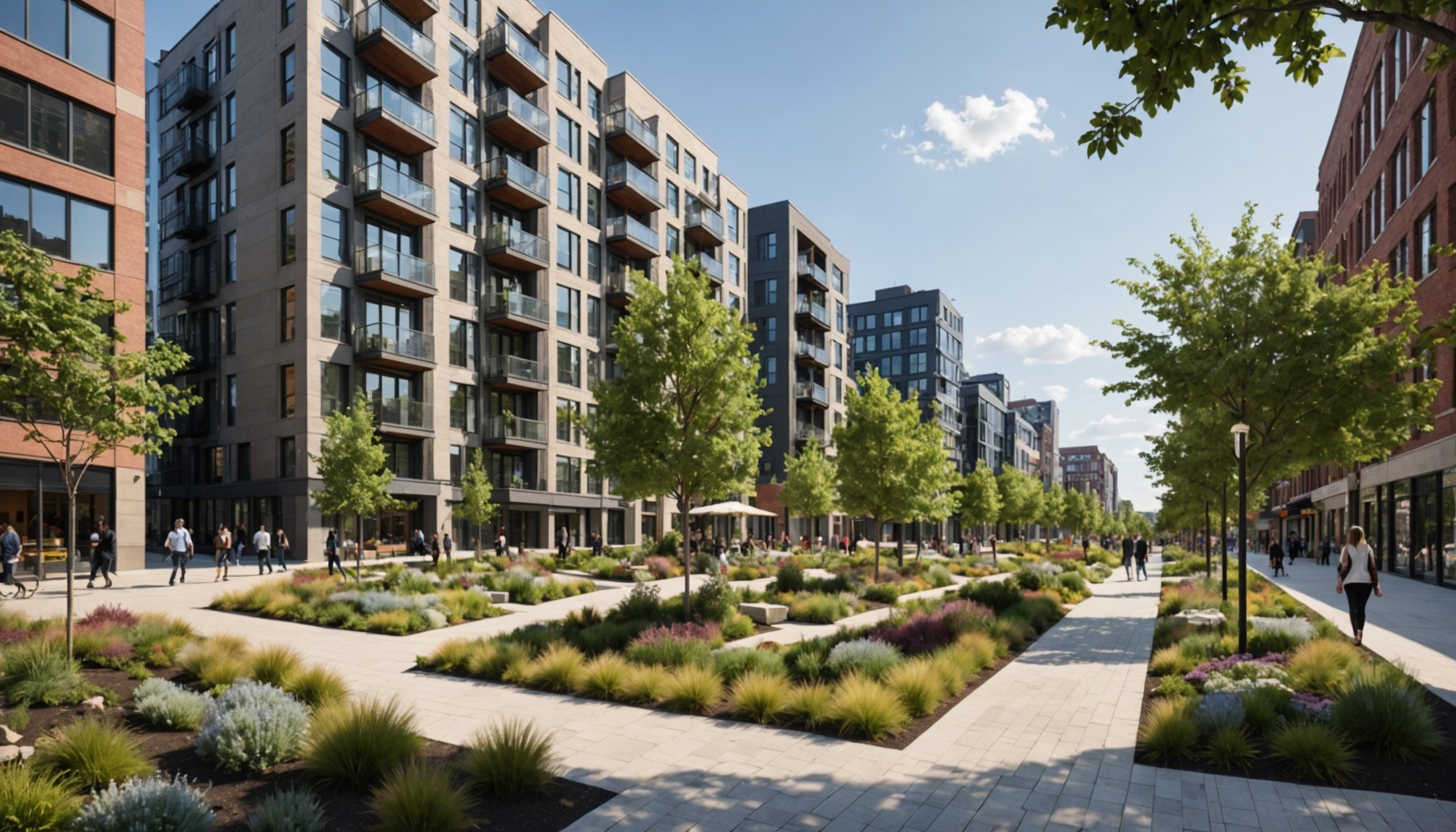Innovative Landscape Design Strategies
Innovative landscape design strategies are vital for enhancing urban biodiversity. Sustainable practices and green infrastructure are at the heart of these designs, aimed at harmonizing urban spaces with nature.
Key Principles of Innovative Landscape Design
Effective landscape design considers environmental sustainability and resilience. It prioritizes native plant species, reduces impermeable surfaces, and minimizes resource consumption. Encouraging biodiversity through thoughtful plant selection is crucial, as it supports pollinators and wildlife, enhancing ecosystem stability.
Additional reading : Discover the enduring benefits of opting for high-quality building materials in your projects
Overview of Green Infrastructure Practices
Green infrastructure practices are integral to promoting sustainability. They include the creation of green roofs, rain gardens, and urban forests. These elements not only help to manage stormwater and reduce urban heat but also provide crucial habitats for diverse species.
Case Studies of Successful Landscape Designs Enhancing Biodiversity
- Millennium Park, Chicago: A prime example, integrating art and architecture with native plantings to create an urban oasis.
- High Line, New York City: Transformed a disused rail line into a vibrant green space, supporting a variety of wildlife.
These case studies illustrate how well-implemented landscape design strategies can significantly enhance biodiversity in urban areas, creating healthier ecosystems and improved quality of urban life.
Also read : Revamping Real Estate: Key Approaches to Integrate Sustainable Urban Farming Practices
Overview of Urban Biodiversity
Urban biodiversity is essential for maintaining ecological equilibrium in city environments. It plays a significant role in providing valuable ecosystem services that benefit both the environment and urban populations. These services include air purification, temperature regulation, and pollination, which are crucial for urban health and sustainability.
However, urban biodiversity faces numerous challenges, largely due to urban development. The expansion of cities often results in habitat fragmentation and loss, adversely affecting local species. Additionally, pollution and climate change further exacerbate these challenges by disrupting natural habitats and altering ecosystems.
The importance of preserving biodiversity in urban areas cannot be overstated. It not only enhances the resilience of urban ecosystems but also contributes to the well-being of city inhabitants. Biodiverse environments attract more wildlife, increase green spaces, and improve the quality of urban life. Therefore, integrating biodiversity considerations into urban planning and development is paramount.
Cities must adopt innovative and practical strategies to promote and protect biodiversity. This includes creating habitat corridors, reducing invasive species, and prioritizing native plants that support local wildlife. Collaborative efforts between policymakers, urban planners, and communities are essential to successfully address these challenges and ensure a sustainable urban future.
Benefits of Enhancing Biodiversity in Urban Development
Enhancing biodiversity in urban areas offers a myriad of benefits, playing a pivotal role in promoting urban health and fostering sustainable development.
Economic Benefits
Investing in urban biodiversity can yield significant financial returns. Ecosystem services provided by biodiverse environments, such as stormwater management and temperature regulation, translate into substantial cost savings. Reduced need for artificial infrastructure and lower energy consumption directly benefit municipal budgets and household finances.
Health and Well-being Benefits
Urban green spaces enriched with biodiversity positively influence mental health. Natural environments provide therapeutic experiences, reducing stress and improving emotional well-being. Additionally, the presence of diverse plant species improves air quality and encourages physical activities like walking or jogging, contributing to better physical health.
Community and Social Benefits
Biodiversity in urban settings enhances community cohesion and engagement. Green spaces become venues for social interaction, fostering a sense of neighbourhood identity. Moreover, they offer accessible recreational opportunities, encouraging outdoor activities and inclusivity. By promoting shared spaces that benefit everyone, urban biodiversity supports diverse and dynamic urban communities.
Practical Guidelines for Implementation
Implementing urban biodiversity through best practices and urban planning is essential to fostering sustainable communities. A step-by-step process can facilitate the integration of biodiversity into real estate projects. This begins with conducting a thorough assessment of the site to understand environmental aspects and existing ecosystems. Next, prioritising native plant species can enhance local biodiversity by supporting existing wildlife. Selecting the right materials is also crucial; opt for sustainable, recycled, or regionally sourced materials to further minimise environmental impact.
Community engagement plays a critical role in the successful implementation of biodiversity initiatives. Involving stakeholders, including residents and local organisations, fosters a sense of ownership and ensures the project reflects the community’s needs and vision. Encouraging input from these groups in the design process can lead to more effective and accepted outcomes.
Additionally, investing in ongoing maintenance and education programs is vital. This ensures the sustainability of biodiversity efforts and encourages community members to continue supporting these habitats. Implementers should also focus on creating green corridors that connect natural areas, facilitating species movement and genetic diversity. By adhering to these best practices, urban developments can significantly enhance their ecological footprint and overall sustainability.
Regulatory Considerations and Policies
Navigating the complex realm of urban policy and biodiversity regulations is essential for fostering biodiversity. Cities with successful biodiversity policies exemplify innovative strategies to enhance biodiversity while maintaining compliance with regulations.
Urban areas are governed by various planning frameworks that prioritize biodiversity. These frameworks often emphasize the protection of natural habitats and the incorporation of green spaces into urban landscapes. Key strategies include the integration of native species and the preservation of existing ecosystems, which are detailed in policy guidelines to aid urban planners and developers.
Cities like Amsterdam and Singapore have established themselves as leaders in biodiversity-friendly urban planning. Their policies focus on maintaining ecological balance through dedicated green corridors and urban parks, which not only support biodiversity but also enhance the quality of urban life. These case studies provide valuable insights into the positive impacts of well-designed policies.
For effective compliance with biodiversity initiatives, developers must stay informed of both local and national standards. This includes regular updates on environmental impact assessments and community consultations. Engaging with policymakers and environmental experts ensures that urban development aligns with environmental goals, safeguarding biodiversity for future generations.
Visualizing Urban Biodiversity
Visual tools are increasingly crucial in advocating for urban biodiversity. They help stakeholders understand its value by illustrating benefits and changes over time using engaging formats like infographics and before-and-after images.
Impact of Visualization
Visualization assists in articulating the significance of biodiversity, often overlooked in urban planning. Well-crafted infographics can distil complex information into comprehensible visuals, highlighting the symbiotic relationship between urban areas and natural habitats. This understanding encourages stakeholders, from developers to community members, to embrace green initiatives.
Before-and-After Case Studies
Case studies with before-and-after images demonstrate the tangible impacts of incorporating biodiversity into urban infrastructure. These visuals make the contrast clear, showing enhancements in both environmental health and aesthetic appeal. Documented transformations can serve as templates, guiding future projects in effectively integrating biodiversity.
Expert Insights and Interviews
Gaining perspectives from industry experts enriches the discourse on urban development. Interviews with landscape architects and environmental scientists provide valuable insights into successful design approaches. For example, an industry leader might highlight the economic and ecological advantages of integrating biodiversity, reinforcing its pivotal role in real estate projects.
Visualizing biodiversity thus acts as a compelling tool, fostering informed decision-making among urban planners and stakeholders.

